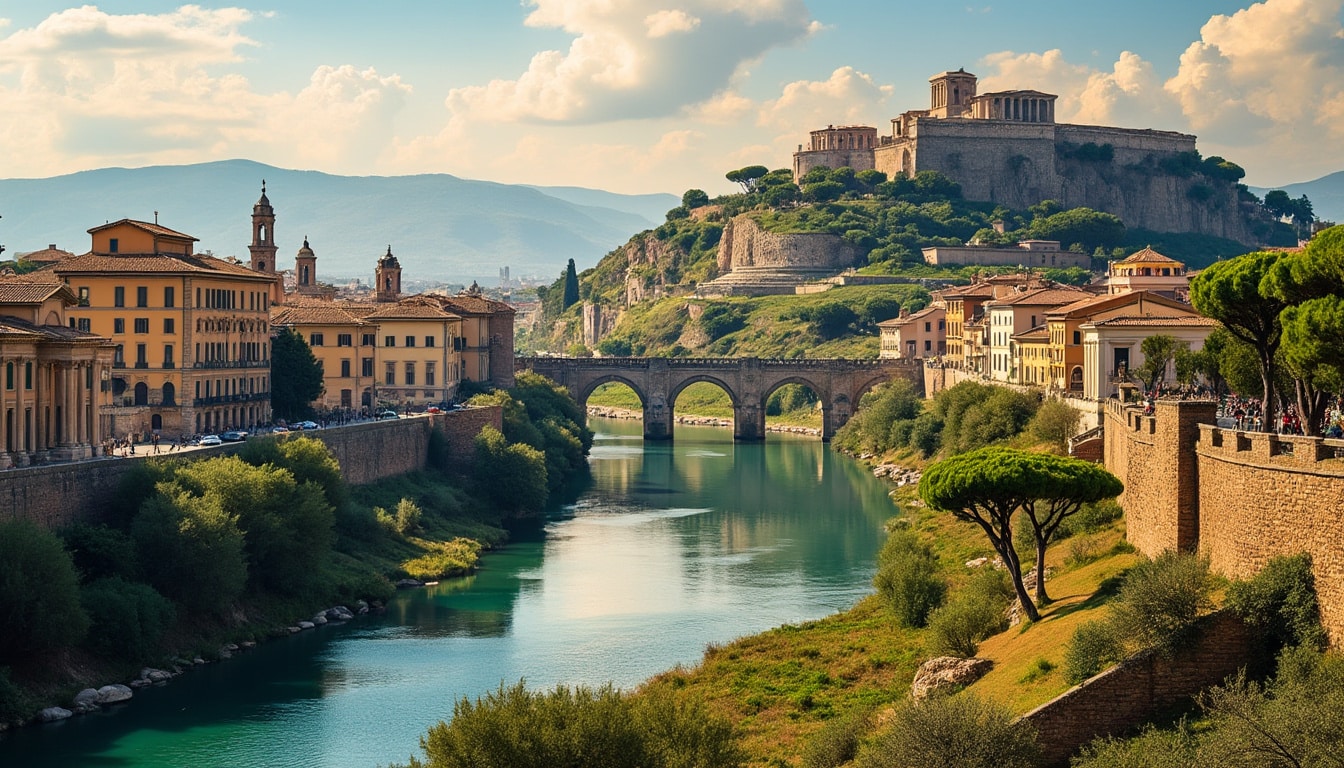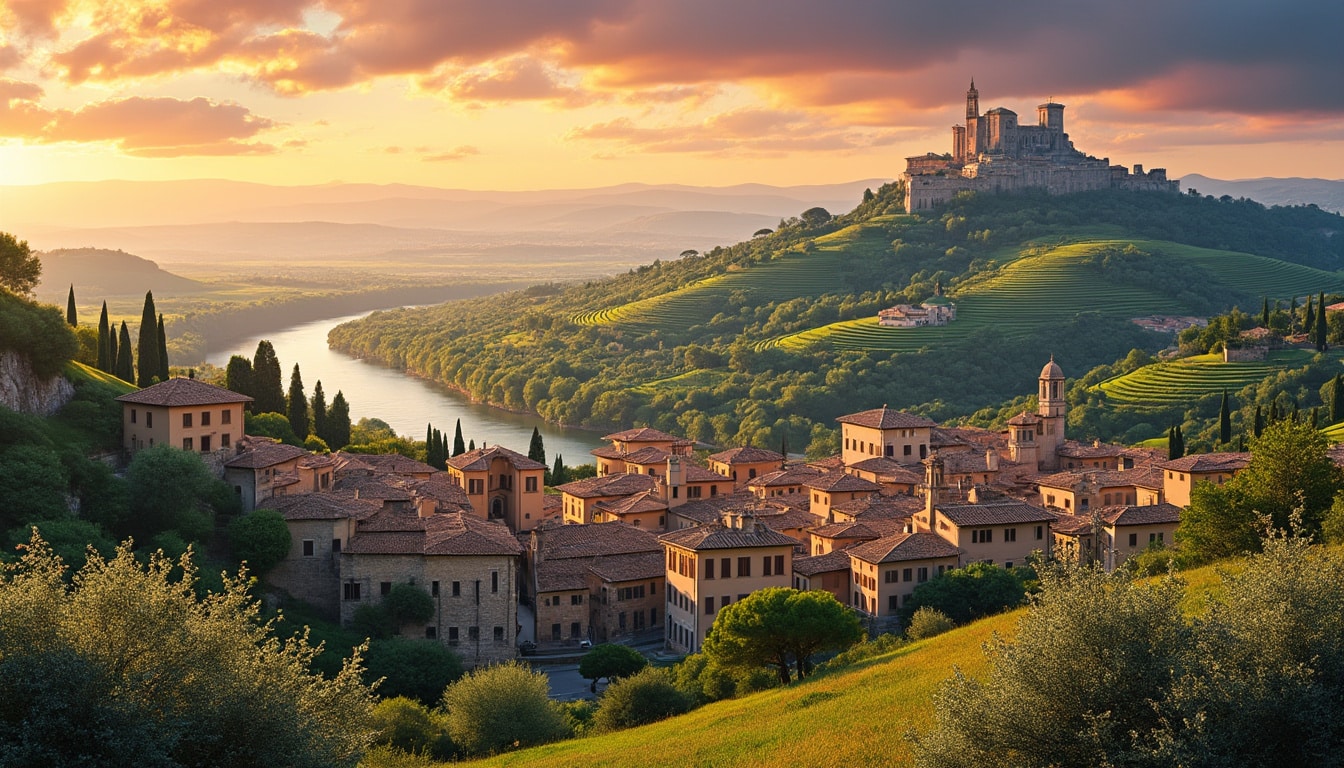When one thinks of Rome, often the images that spring to mind are of ancient ruins, breathtaking art, and delicious cuisine. However, it’s the geography and natural surroundings of this timeless city that have played a pivotal role in shaping its historical narrative. Positioned strategically on the Italian Peninsula, Rome’s landscape is not only a feast for the eyes but also a significant contributor to its development as a world power. From the characteristic Seven Hills to the iconic Tiber River, each element has its story to tell. This exploration of Rome’s geographical wonders will reveal how these natural features intertwine with its rich cultural tapestry.
The Iconic Seven Hills of Rome
The majestic city of Rome is famously known as “the city of seven hills.” These hills form the heart of this ancient metropolis and have been central to its history and cultural evolution. Each hill boasts unique stories and landmarks that speak volumes about Rome’s illustrious past.
1. Palatine Hill:
The Palatine Hill is celebrated as the legendary birthplace of Rome. It sits at the very core, both geographically and historically. According to tradition, this is where Romulus founded the city, laying the foundations for the Roman civilization. Today, the Palatine Hill overlooks the Roman Forum and hosts a range of imperial remains, providing a mesmerizing glimpse into the ancient world.
2. Capitoline Hill:
This hill, known as “Capitolin,” was a center of religious power during antiquity. It presently houses the Capitoline Museums and the famed equestrian statue of Marcus Aurelius. The history embedded within Capitoline Hill is like an open book, narrating tales of past rituals and significant events.
3. Aventine Hill:
Renowned for its peaceful aura, Aventine Hill is a residential area dotted with lush gardens, the Santa Sabina Church, and the celebrated keyhole that offers a picturesque view of St. Peter’s Basilica. Its soothing ambiance makes it a favorite spot for both locals and tourists.
4. Caelian Hill:
Drenched in Christian history, Caelian is home to many ancient basilicas, including San Giovanni in Laterano, the cathedral of Rome. Walking through this hill offers a serene retreat into a world where religion and history merge beautifully.
5. Esquiline Hill:
The largest of all seven, Esquiline Hill shelters monumental sites such as the Basilica of Santa Maria Maggiore. It also whispers tales of Roman folklore through the remnants of Trajan’s Market. Its multicultural environment today stands as a testament to Rome’s evolving narrative.
6. Viminal Hill:
The smallest of them all, Viminal Hill may be unassuming but is now a bustling administrative district. It houses the Ministry of the Interior and the Rome Opera, making it an important part of modern-day Rome.
7. Quirinal Hill:
Dominated by the Quirinal Palace, this hill is steeped in history linked to Roman temples and baths. Serving as the official residence of the Italian President, it dominates the city with its stature and historical gravity.

Exploring these hills offers a dive into historical nature, unveiling intriguing anecdotes and architectural marvels. For those eager to delve deeper, booking a guided tour of the Palatine Hill is highly recommended. After all, each hill provides a unique panorama that weaves together stories from Rome’s past into its legendary geography.
The Grand Tiber River: Rome’s Lifeline
Flowing gracefully through Rome, the Tiber River is an emblematic symbol of the city. This waterway, spanning 405 kilometers from the Apennine Mountains to the Tyrrhenian Sea, has profoundly influenced Rome’s topography and history.
The Tiber River acts as a natural border, separating iconic districts like Vatican City and Trastevere from other parts of Rome. Its significance goes beyond just geography; it has been central to Rome’s economic development and cultural fabric throughout centuries.
| Element | Relevance to Rome | Historical Impact |
|---|---|---|
| Trade | Aided ancient trade routes | Boosted economy by linking Rome to the Mediterranean |
| Defense | Natural barrier against invaders | Helped maintain city security |
| Cultural Symbol | Legends of Romulus and Remus | Integral to Roman myths and heritage |
| Transportation | Facilitated movement of goods and people | Key to expansion and connectivity of the Roman Empire |
The river’s history is interwoven with legends, such as the tale of Romulus and Remus, who were found along its banks. Over the years, the Tiber has witnessed various events, from rituals to military campaigns. Although known for its charming allure today, the river has also been infamous for flooding, adding an element of unpredictability to Rome’s climate. For those interested in learning more about these natural risks, a visit to Rome Circuit provides detailed insights.
An adventure along the Tiber River is a staple in any Rome Tours itinerary, offering insights into the city’s past and present. Be it a leisurely stroll or an Eco Rome river cruise, the Tiber invites explorers to uncover the mysteries of this eternal city.
Rome’s Mediterranean Climate: A Traveler’s Delight
Rome’s geographical position near the Tyrrhenian Sea endows it with a delightful Mediterranean climate. The city experiences warm, mild summers and cooler, wet winters, making it a year-round destination for travelers.
During the warm months from June to September, temperatures range from a balmy 14°C to around 30°C. It’s during this time that Rome Outdoor Adventures truly come to life, with chances to explore Roman Parks & Gardens. As the city transitions to winter, temperatures drop slightly, making layers advisable for those dreaming of a Roman winter wonderland.
- 🌞 Summer (June – September): Ideal for outdoor activities and sunset strolls along the Tiber.
- ❄️ Winter (December – March): Experience a quieter Rome with cozy local markets such as the Esquilino Market.
- 🌿 Spring (April – May) / Autumn (October – November): Perfect for Nature Walks Rome, offering a beautiful blend of comfortable weather and fewer crowds.
Despite the occasional heavy rain between October and January, the rainfall is moderate, enhancing rather than detracting from Rome’s charm. The city’s inviting climate encourages sustainable Rome explorations and wildlife tours throughout the year.
Travelers looking to navigate Rome’s seasons can find more detailed climate information at Rome Circuit. Whether basking in the summer sun or embracing the winter chill, each season in Rome brings unique opportunities for exploration and discovery.
Exploring Rome’s Diverse and Vibrant Districts
Rome’s geography isn’t just about hills and rivers; its diverse districts add to the city’s colorful tapestry. Each area presents a unique blend of culture, attractions, and experiences, and wandering through them reveals yet another layer of Rome’s identity.
Here are some of the key districts:
- 🌿 Centro Storico: The heartbeat of historical Rome, featuring monuments like the Pantheon and intimate, cobblestone alleys.
- 🎉 Trastevere: Known for its bohemian vibe, this picturesque area offers ancient churches and vibrant nightlife.
- 🏛️ Vaticano: Home to the Holy See, with world-renowned attractions like St. Peter’s Basilica and the Vatican Museums.
- 🍴 Testaccio: A food lover’s paradise with bustling markets and a lively nightlife scene that draws crowds from all over.
- 🏡 Aventine: Perfect for those seeking tranquility, with beautiful gardens and breathtaking views of the city.
Whether one desires an artistic afternoon in Monti or a gastronomic adventure in Testaccio, exploring these districts complements any Rome Wildlife Tours. It showcases how the city harmoniously blends ancient history with modern vibrancy. Detailed guides on Rome’s districts can be discovered on platforms such as Rome Circuit.
The Relationship between Roman Geography and Urban Expansion
Rome’s physical layout has not only dictated its historical development but also its modern urban planning. The city’s geography inherently promotes diverse land use, awing residents and visitors alike with its spatial harmony.
Imagine Roman Parks & Gardens seamlessly woven into urban life, without compromising on the city’s cultural ethos. These green spaces are more than just recreational areas; they serve as ecological sanctuaries, supporting the concept of Green Rome Travels.
| Geographic Feature | Urban Impact | Modern Significance |
|---|---|---|
| Roman Hills | Determined initial settlement patterns | Historic sites amidst urban density |
| Tiber River | Facilitated trade and transport routes | Tourism and leisure activities hub |
| Climate | Influences architectural style | Promotes outdoor tourism industry |
| Coastal Proximity | Allowed for maritime commerce | Ecotourism and beach access |
As the city continues to grow, so does the challenge of balancing historical preservation with urban modernization. Rome’s commitment to innovation and sustainability is evident in its progressive policies and initiatives. Learn more about the city’s evolving dynamics and sustainable efforts at Rome Circuit.
With every corner a testimony to Rome’s enduring legacy, its geography continues to shape the story of this epic city.
FAQs: Navigating the Geography of Rome
- 📍 What are the main physical features of Rome? The Seven Hills and the Tiber River are Rome’s most notable features, contributing significantly to its historic and modern character.
- 🌿 When is the best time to visit Rome? Spring and autumn offer the most favorable weather, with pleasant temperatures ideal for exploring the city’s natural and urban offerings.
- 🏛️ How do Rome’s geographic features influence tourism? They contribute to a dynamic tourism industry, offering everything from historical tours to nature walks and eco-friendly adventures.

